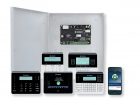
Headlines
News
Home away from home: enterprise and residential security commonalities
When it comes to examining the relationship between home- and enterprise-based security systems, you should remember one thing, according to J.P. Lapointe, Canada leader/general manager at Honeywell Security and Fire: “users are users.”
March 15, 2017 By Renée Francoeur

“Whether it’s at home or at the office, users expect a similar, if not identical, experience,” he says.
That means the enterprise side of things has had to get a move on when it comes to adapting to the increasingly smarter smart home trend. But it also means the residential market has taken some pointers from enterprise. We explore both, looking at how they’ve been scratching each other’s backs, or sometimes just missing that itch.
Smart buildings
Traditionally, security systems were a necessity for enterprises. For homes, they came as an add-on or afterthought, and usually only for an elite group. While this may be true in some cases, today, we see the “experience” of automated, integrated security systems making home-based ones that much more attractive and reachable.
The home-based market in Canada is still hovering around 20-25 per cent in terms of penetration, whereas enterprise is practically 100 per cent, Lapointe reminds us.
“Enterprise is driven by different factors, such as regulations, insurance, liability, protection of critical infrastructure or sometimes productivity. Those are different needs an enterprise customer is looking to fill whereas in home, in the past, it was all about a security product. I think that’s why the market penetration was what it was, because the majority of the population didn’t feel like it was a need for their lifestyle,” he says.
As more homes become more connected, this could start to change. “Maybe not everyone is interested in an alarm system but maybe they’re interested in viewing in real time what’s going on around their pool through a smart device,” Lapointe suggests.
A report, authored by IHS Markit’s smart home and security technology principal analyst Blake Kozak, says in 2023, professionally monitored smart homes will exceed non-connected, traditionally monitored security systems. His report also expects the penetration of smart home systems to double by 2025.
That means more touchscreens, self-contained intruder alarm panels (which contain several radios such as Wi-Fi, Z-Wave and ZigBee), remote monitoring and a heightened amount of automation, Kozak says, for video surveillance, thermostats, water leak detection and garage door control, as a few examples.
As such, a desire for similar connectivity is now creeping into the enterprise side of things.
Apps & interfaces
“Combining security systems with building automation features so the operator only has one interface is popular,” says Paul Garms, director of regional marketing at Bosch Security, North America. “It may have started on the residential side, but we’re seeing it more and more on the enterprise side.”
It helps, he adds, that wireless standard formats like ZigBee and Z-Wave, allow for the control of multiple devices and are something everyone can use — home or enterprise.
This drive for integration and remote monitoring is one big similarity between enterprise and home systems, and as an example, Garms points to Bosch’s B series family of intrusion panels, which cater to the small commercial market as well as high-end residential.
“It has integrated capability where you can directly integrate flash IP cameras to the panel, access control to control doors, but it also has the smart home interface for residential or business,” he notes.
The panel family also supports both IPv4 and IPv6 and remote command with free apps.
Controlling your systems through an app was a residential undertaking to begin with, Garms notes, and it has impacted enterprise systems due to its ease and Millennial appeal.
“Bosch is primarily what you term an enterprise or commercial focused company,” he says, “but we do offer apps for commercial grade systems — it’s commonplace, because everyone is so comfortable with them now.”
“Home based systems have to be easy to use and intuitive with touchscreens,” Garms adds. “That ease-of-use is something we’ve learned from the resi. In the past, one guy at the company learned all the commands to arm the system. Now, there’s higher turnover and people don’t want to read manuals, which is affecting how we market and sell the product.”
Additionally, for enterprise access control, where biometrics is gaining traction, according to Kozak, the remote monitoring capabilities via a smart device are also very attractive to end users.
The marketing glitz
According to Lapointe, it’s all about observing how people use the product in both markets and looking at how to make “that experience smoother so the end user can see the value, too”—infusing a “lifestyle” perspective into the marketing and remembering “home is an emotional experience.”
Living up to its ease-of-use preaching, it was time to take Bosch onto YouTube, Garms says.
“We’ve put up videos showing people how to install systems and products and this was something the residential space had been doing for a while.”
Another marketing takeaway from the residential market, according to Garms, was the message to hone in on the end user.
“As a manufacturer we sell to installers and dealers, so we focus on what makes it easy for them to install but more and more we’re taking it a step further and looking to provide marketing and sales tools, brochures, etc. to those in our Bosch Authorized Security Dealer program for them to give to their clients and help the end user.”
Bosch has historically only gone to market through a direct dealer network, Garms says, but with the aforementioned B series panels, the company decided to “open that up in distribution through Tri-Ed/Anixter and a distributor called ScanSource, and made it available to essentially, all dealers.”
For Cropley, a principal market analyst at IHS, the appealing factors in DIY changes the game between enterprise and home systems marketing. “A significant portion of the home-based systems can be sold as DIY products through in-store or online versions of common electronics or big box retailers such as Costco, Wal-Mart or Best Buy,” he says. “This is not a common approach for the professional-grade market where equipment typically reaches end users via their integrator or installer, who have either purchased it through distribution channels or direct from the manufacturer.”
It is no secret that the DIY market has taken revenue from professional channels because of the innovation and design flexibility of DIY versus the often vertically integrated and proprietary nature of professional offerings, Kozak adds. “As a result, service providers with vertically integrated ecosystems need to be quick to market with in-house innovation as well as necessary third-party integrations, such as voice control with Alexa Skills or Google Home.”
Moreover, he continues, integrations with “automotive, well-being (independent living and digital/telehealth) and multi-room audio will ensure differentiation, future proofing and additional revenue streams.”
Overall, innovation is critical for service providers in the smart home, Kozak says, highlighting that the future of the smart home will have less focus on safety and security devices and more focus on automation, user experience and ecosystems.
Analytics & payments
Also, video analytics, which were traditionally associated with enterprise systems, have filtered down into home DIY video surveillance systems.
“Many inexpensive DIY cameras feature forms of analytics from basic trip wires to ‘zones of interest’ to even face detection,” Cropley notes, all of which were once considered enterprise territory.
However, enterprises have learned how the Cloud can better be used for video surveillance systems from home-based initiatives, Cropley argues, adding they have also learned to consider alternative payment models, “like paying monthly for video surveillance as a service rather than buying equipment outright.”
Similarly, consumers are beginning to expect alternatives to long-term contracts in the form of on-demand billing, professional installation with self-monitoring or DIY installation with professional monitoring, according to Kozak.
“For security providers, these alternative models can be an additional source of recurring monthly revenue (RMR) for dealers seeking quick installations with minimal effort required,” he says.
Thermal not just for enterprise
More thermal cameras are also making their way into high-end residential, as prices come down, says Wayne Hurd, vice-president of distribution sales for FLIR Systems, Security & Surveillance, but it’s “still in its infancy.”
“In the future, I see even more coming to upper-middle class homes,” Hurd says, “because they do things that are quite interesting, like putting up a thermal fence, and there’s different variations of camera lens, so you can set up a wide angle for the backyard, for example.”
For FLIR, advances on the enterprise side — like Cloud-based analytics — are what drives down to the residential, Hurd says, and both are marketed similarly. “We do something on the enterprise side first, then make adjustments for the residential.”
He notes FLIR’s fairly new FC line for perimeter protection suits both commercial and residential needs, as the series has analytics built in to identify humans or animals.
Wireless vs. wired
The use of wireless video surveillance in enterprise remains less common compared to home security, according to Garms.
Equipment cost is always a concern for enterprise customers, Garms continues, and retrofitting existing buildings with new security systems is typically more cost efficient with wired selections.
He says he’s seeing more wireless solutions in smaller enterprise applications and that it’s been a big offering for a number of years. The larger ones do still favour wired, he says, “simply because there are fewer batteries to replace and, if you go too large, you need repeaters and that sort of thing with wireless. Maintenance was a concern.”
That being said, enterprise is learning the benefits of wireless, Lapointe notes. “Maybe there’s a little higher cost on hardware, but if there’s a value proposition that equates to one technician spending maybe 50 per cent less time because of a wireless solution, that enables a retrofit to be much more easier to do. And those are types of solutions that enterprise customers are looking for.”
“Personally, I feel enterprise is adopting wireless quicker now, because it’s proven its credibility on the home front,” Lapointe asserts.
Additionally, DIY home security cameras are often Wi-Fi cameras, Cropley notes.
“This is not the case in many professional grade installations—whether an enterprise system or not. Often cameras that are required to be more distributed and might require extensive cabling, such as in parking lot, may be connected to a wireless radio node but the rest of the system may be on nearby buildings and be wired. Building out a stable, wireless network for modern, high-resolution video surveillance cameras remains technically difficult and can be expensive,” he says. “But wireless still may be the most cost effective option where wired cabling would not be suitable or too disruptive, like in a city centre or for isolated cameras.”
Meanwhile, in the wireless electronic locks department, enterprise is “certainly on par” with the home-based security, according to Kozak.
“Despite the slow moving nature of access control, wireless electronic locks have been a true success story,” he says. “Wireless locks for enterprise has changed the game because it allows installers and integrators to put access control where it may not have been financially feasible 10 years ago. This means remote locations such as a utility substation or network tower or interior doors of a building. Wireless locks have helped expand the access control market.”
Intelligent & integrated
As both enterprise- and home-based security systems evolve to become increasingly integrated and intelligent, the markets have much they can share and take away from one another.
“I think that quickness to market, looking at what the end user wants and adapting to meet those needs is positioning this industry for a fun ride for the next 10-20 years,” Lapointe concludes. “We have to be thinking of how can we come to market with new solutions, software that’s easier to install and use, and easy to maintain overall over a long period of time so the end user, whether at home or in the office, can see the value of what they’re investing in.”
Print this page
Advertisement
- A tale of two companies: Success has so many variables, check key metrics
- Smart home system from Interlogix



